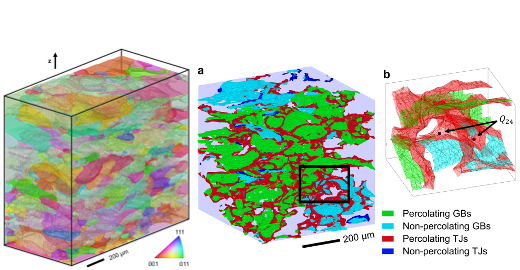
Grain boundary percolation studied by LabDCT
Grain boundaries (GBs) in a polycrystalline material provide faster diffusion paths (by orders of magnitude) compared to the intragranular lattice. This means that damage will accumulate when a connected pathway of failure-susceptible GBs span the material. The framework of bond percolation theory provides a natural description of connectivity and enables analysis of the GB network with ‘bonds’ representing the GBs. Some bonds are ‘open’ (or failure-susceptible, here the high-angle random GBs) while others are ‘closed’ (or failure-resistant and immune).
Experimental LabDCT results help guide the design of polycrystalline materials that may otherwise fail due to the percolation of damage
In a new study, headed by Prof. Ashwin Shahani from University of Michigan, percolation theory was applied to study GB networks in a real, experimentally-obtained 3D microstructure for the first time. The study was made possible due to new strides in 3D, non-destructive and high-throughput characterization, via LabDCT on an Al-3.5wt%Cu alloy as model system. More than 10,000 GBs in almost 2000 sub-surface grains were analyzed for the study.
Acta Materialia
Percolation of grain boundaries and triple junctions in three-dimensions: a test of theory
By the same authors
Harnessing LabDCT to understand dynamics of liquid metal penetration
Dynamics of particle-assisted abnormal grain growth
